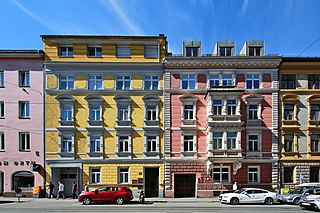
Innsbruck is the capital of Tyrol and the fifth-largest city in Austria. On the River Inn, at its junction with the Wipp Valley, which provides access to the Brenner Pass 30 km (19 mi) to the south, it had a population of 132,493 in 2018.
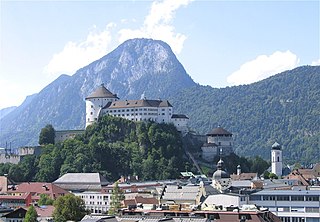
Kufstein is a town in the Austrian state of Tyrol, the administrative seat of Kufstein District. With a population of about 20,000 it is the second largest Tyrolean town after the state capital Innsbruck. The greatest landmark is Kufstein Fortress, first mentioned in the 13th century. The town was the place of origin of the Austrian noble family Kuefstein.

The Medical University of Innsbruck is a university in Innsbruck, Austria. It used to be one of the four historical faculties of the Leopold-Franzens-Universität Innsbruck and became an independent university in 2004.

Landeck is a city in the Austrian state of Tyrol, the capital of the district of Landeck.

Merano or Meran is a comune (municipality) in South Tyrol, Northern Italy. Generally best known for its spa resorts, it is located within a basin, surrounded by mountains standing up to 3,335 metres above sea level, at the entrance to the Passeier Valley and the Vinschgau.

Seefeld in Tirol is an old farming village, now a major tourist resort, in Innsbruck-Land District in the Austrian state of Tyrol with a local population of 3,312. The village is located about 17 km (11 mi) northwest of Innsbruck on a plateau between the Wetterstein mountains and the Karwendel on a historic road from Mittenwald to Innsbruck that has been important since the Middle Ages. It was first mentioned in 1022 and since the 14th century has been a pilgrimage site, benefiting not only from the visit of numerous pilgrims but also from its stacking rights as a trading station between Augsburg and the Venice. Also since the 14th century, Tyrolean shale oil has been extracted in the area. Seefeld was a popular holiday resort even before 1900 and, since the 1930s, has been a well known winter sports centres and amongst the most popular tourist resorts in Austria. The municipality, which has been the venue for several Winter Olympics Games, is the home village of Anton Seelos, the inventor of the parallel turn.

The Goldenes Dachl is a landmark structure located in the Old Town (Altstadt) section of Innsbruck, Austria. It is considered the city's most famous symbol. Completed in 1500, the roof was decorated with 2,657 fire-gilded copper tiles for Emperor Maximilian I to mark his wedding to Bianca Maria Sforza. The Emperor and his wife used the balcony to observe festivals, tournaments, and other events that took place in the square below.

The Volksgarten is a public park in the Innere Stadt first district of Vienna, Austria. The garden, which is part of the Hofburg Palace, was laid out by Ludwig Remy in 1821. The park was built over the city fortifications that were destroyed by Napoleon in 1809. The Volksgarten was opened to the public in 1823.

Tyrol is a historical region in the Alps of Northern Italy and western Austria. The area was historically the core of the County of Tyrol, part of the Holy Roman Empire, Austrian Empire and Austria-Hungary, from its formation in the 12th century until 1919. In 1919, following World War I and the dissolution of Austria-Hungary, it was divided into two modern administrative parts through the Treaty of Saint-Germain-en-Laye:

Joseph Ennemoser was a South Tyrolean physician and stubborn late proponent of Franz Mesmer's theories of animal magnetism. He became known to English readers through Mary Howitt's translation of his History of Magic.

Edgar Meyer (1853–1925) was an Austrian painter who built himself a castle and engaged in politics.

HelblingHouse is a building located in the Old Town (Altstadt) section of Innsbruck, Austria, across from the Golden Roof at Herzog-Friedrich-Strasse 10. The original structure was built in the fifteenth century, but evolved significantly with new architectural styles in subsequent centuries.
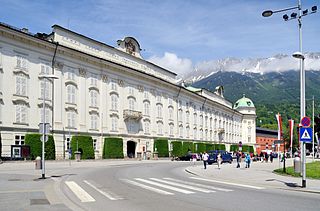
The Hofburg is a former Habsburg palace in Innsbruck, Austria, and considered one of the three most significant cultural buildings in the country, along with the Hofburg Palace and Schönbrunn Palace in Vienna. The Hofburg is the main building of a large residential complex once used by the Habsburgs that still includes the Noblewomen's Collegiate Foundation, the Silver Chapel, the Hofkirche containing Emperor Maximilian's cenotaph and the Schwarzen Mandern, the Theological University, the Tyrolean Folk Art Museum, Innsbruck Cathedral, the Congress, and the Hofgarten.

The Innsbrucker Hut is a mountain hut in the Stubai Alps at an altitude of 2,369 metres (7,772 ft) in the Gschnitz Valley, not far from the Pinnisjoch. It is managed by the Innsbruck Tourist Club section of the Austrian Alpine Club. The Innsbrucker Hütte is below the Habicht on the Stubai Hohenweg and is often visited.
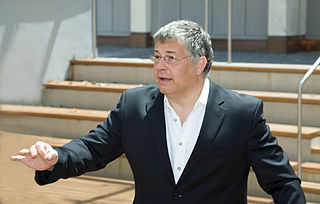
Bernhard Sieberer is an Austrian choirmaster and conductor.
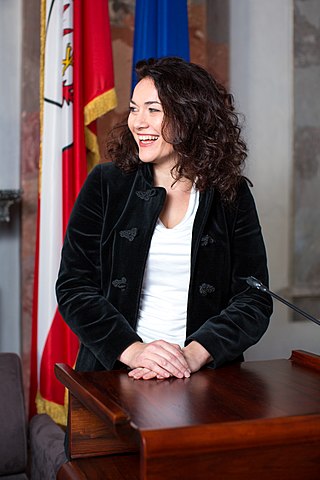
Ingrid Felipe is an Austrian businesswoman and former politician from the Green Party. She was second deputy Governor of Tyrol from May 2013 until October 2022 and from June to October 2017, she served as federal spokeswoman of her party.

The Tirol Panorama with the Museum of the Imperial Infantry or Tirol Panorama is a museum in Innsbruck in the Austrian state of Tyrol, which is mainly important because it houses the Innsbruck Giant Panorama Painting.
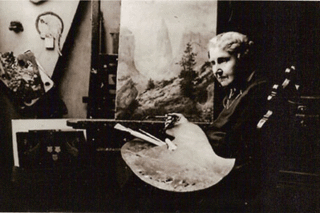
Gabriele Maria Deininger-Arnhard (31 July 1855 in Munich – 19 October 1945 Rum, Tyrol) was a German-Austrian painter.
The Andreas Hofer Kreuzer, also called the Hofer Kreuzer or Sandwirtszwanziger, was the name of the 20- and 1-kreuzer coins that were minted during the Tyrolean Rebellion in Hall in Tirol in 1809. The obverse depicts the Tyrolean Eagle and the inscription Gefürstete Grafschaft Tirol; the reverse shows the nominal value.



















